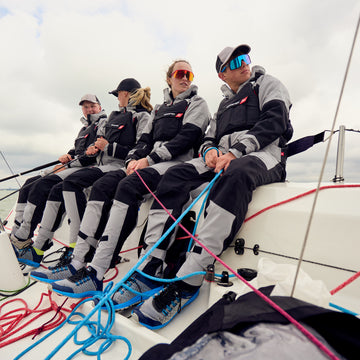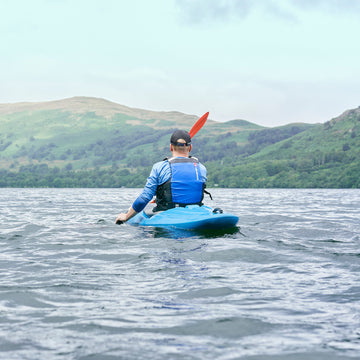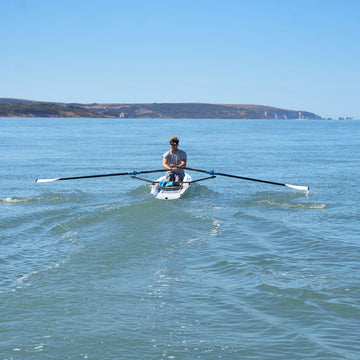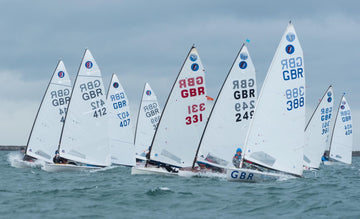
When I was coaching the UK Europe Squad back in the late 90's, I had some technical help from Sid Howlett who at the time was Ben Ainslie's technical coach for the Finn. Sid explained that standard Finn mast bend profile was:
The mast should have 100% of the fore/aft bend number at the half point (between the bands) with 50% at the quarter and 50% at the 3/4 point. Effectively a perfect segment of a large circle which makes fitting the sail to the mast very easy especially with increasing or decreasing sheet tension. We have to hope that the mast will bend uniformly with increased tension in your sheet - which if it has this bend profile means it probably will.
The side bend profile was harder to describe. But Sid wanted 20% of the side bend 1/4 from the hull and 80% of the side bend at the 3/4 point - this measured with a tip weight. Now don't confuse the side bend numbers given by the mast manufacturer with the actual side bend as what we want is away from vertical and the mast is measured from tip to black band.
Below decks - the mast should be super stiff sideways - and springy fore and aft. A springy fore and aft mast below decks might enable more gust response as the gust will attempt to open the leech - the spring would then allow the mast to vent aft , opening the leech whilst maintaining the correct mast bend between the bands, which is like an automatic raking system for breeze.
As the wind reduces then the mast recovers (springs forwards) again and the leech returns to the correct profile by itself.
Too springy fore and aft and you struggle for leech tension when working the boat hard.

A below deck springy mast also helps to absorb over sheeting tension and makes up for under sheeted tension. Just imagine if the mast was a solid rod fore and aft - and the perfect leech tension was somewhere between one click on and one click off your ratchet block. That would be frustrating. The spring below decks allows the mast to self govern the power you take in the gusts.
The other conceivable advantage is that you might have to set up your rake slightly further forward to compensate for the spring - which adds to a more upright mast for downwind sailing.
Having said that, the bigger sailors are not looking for much gust compensation as they are keen to take the power. This early venting is great if we are sailing in waves as you want the rig to vent and recover on every wave. If you want to sail high on flat water, perhaps you are looking for less springy under the deck to give you a high power mode.
The Europe coaches at the time were guided by the Finn concept of mast bend.
During the Olympics - many of the sailors had mis-interpreted the mast numbers given by the standard measurement system. They thought that a small number at 1/4 point from the bottom of the mast in the side bend graph meant stiffness - when actually it means flexibility. Think of it as the other half of the measurement away from the vertical as the number you see from the mast maker is not the offset from vertical - but a number that relates to how the mast bends relative to a line from the tip to the lower band. So bigger numbers sideways at the bottom mean that the mast has not bent at the bottom - so it's stiffer. This stiffer number gives more height to windward. This lesson was a hard one for many Olympic sailors and coaches as they also misinterpreted this number and struggled to hold their lane at the Olympics (or so it is rumoured).

"The Danish Concept is different":
A concept that was largely started by Danish sailors was they wanted a mast that had the same fore aft bend numbers as the side numbers - so that the sail's luff curve would always fit downwind, even when the leech was open and twisted. This makes the masts more even in bend and less gust responsive in the top compared to the Finn concept masts which have much more sideways bend at the 3/4 point. However, the sails for the Danish concept tend to be slightly flatter in the head allowing for less vang tension downwind. The boat is easier to handle downwind in breeze as the mast tip does not bend as much towards the bow and the boom is less close to the water due to the less vang required.
I was very much interested in this concept, especially when UK Sails took the first three places at the 2020 Danish Europe Nationals Championships. My experience of bendy tip masts (the Finn concept) was that they caused sticky conditions in the light as the sails caused too much hooking (as it was made to compensate for increasing sideways bend in stronger breezes). Unless you used two sails - one for light with less return in the leech and one for windy that was cut for the increased sideways mast bend.
So the Finn style bend profile tends to use multi changes of sail throughout the conditions to make the optimum speed. This would certainly mess with my head so I was happy to use the Danish concept and stick with a one mast, one sail setup with a Danish UK Sail.











 Select Store
Select Store
 EU
EU
 US
US
